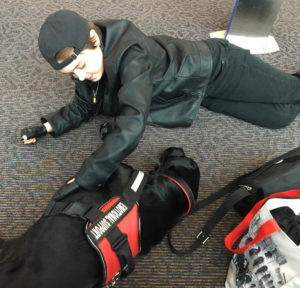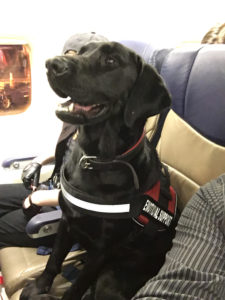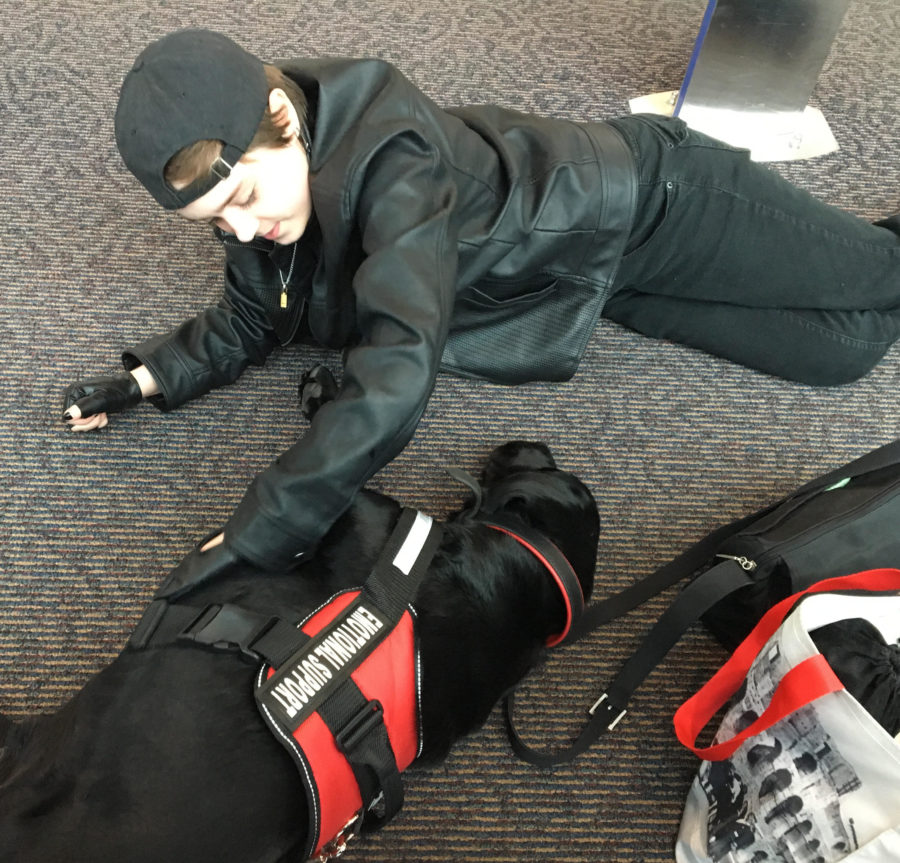
Gomez and Dev in the T.F. Green airport terminalIn addition to High-Functioning Autism, our oldest child Catherine (who lately prefers to be called “Dev”) has struggled with significant and often debilitating anxiety and depression. After nearly a year and a half in and out of the hospital, we decided last April that she was ready to try for a trip to New Orleans to visit my family. This was not undertaken lightly, as she hadn’t traveled by airplane in over two years, and her anxiety is exacerbated not only by crowds but by changes in environment. During such moments, interacting with other humans can add to her stress more than it helps. However, we had long since observed that, like many children on the Autism Spectrum, she is calmed by animals. We decided to give our two-year-old Labrador Retriever, Gomez, a try as an Emotional Support Animal since Dev had quite a bond with him.
Emotional Support Animals are different than the Service Animals we are most familiar with. A Service Animal is not a pet; it is a working animal—typically a dog—specifically trained and certified to perform certain functions to assist its owner with a physical disability. Because they play a critical role in the daily functioning of their owner, federal law requires that Service Animals be permitted to accompany their humans everywhere they go. Emotional Support Animals, on the other hand, do not generally perform specific functions and usually have no specific training or certification. Their role is to strictly provide comfort to their human with an emotional disability (anxiety, PTSD, etc.) The animal isn’t certified; it is the human who must have medical documentation indicating that they have a qualifying condition and benefit from the Emotional Support Animal. Federal law requires that Emotional Support Animals be accommodated by airlines and in housing, but does not entitle the animal to accompany its owner elsewhere. This is a critical distinction between the roles of Service Animals and Emotional Support Animals.

Gomez gets his wings
In our case there was little question that Dev qualified to be accompanied by an Emotional Support Animal during our trip, and we had no problem obtaining an appropriate letter from her psychiatrist using a convenient template provided by Southwest Airlines on their web site. With that documentation in hand, I cannot say enough good things about how Southwest assisted us with our trip. I had called ahead to make sure they were expecting us, and they bent over backwards to help us check in smoothly. They allowed us to pre-board on each leg of the trip so that we could sit in the bulkhead row where there would be more space for Gomez to stretch out at our feet (the ESA isn’t allowed to sit in his own seat, although Southwest let him do so briefly for a photo op.) On the outbound flight they even gave Gomez his “wings” as a first time flyer—a thoughtful and touching gesture. Gomez did his part too. He’s well-trained but still youthful and can be a bit of an “over-greeter” at times. Yet as soon as he donned his red “Emotional Support Animal” vest, he adopted a stoic demeanor and seemed to know he had a job to do. Sure enough, when Dev was feeling anxious in the airport terminal, he lay down on the floor with her, and when she was unsettled in flight he sat up and put his head in her lap so she could pet him. (Being an Emotional Support Animal is not at all a bad gig for an attention-loving labbie!) Even while we were in New Orleans, Gomez continued to provide support to Dev when she struggled at times to cope with the challenges of being in different surroundings.

Gomez enjoying a brief moment in a “human” seat
Recent focus on traveling Emotional Support Animals has garnered a lot of negative press—much of it warranted. Emotional Support Animals such as Gomez provide invaluable assistance to individuals struggling with emotional disabilities, enabling them to be mobile and function in ways that might otherwise be difficult or impossible. Unfortunately, such emotional disabilities are difficult to define and many out there have seized on these laws as a loophole allowing them to simply bring their pet along on vacation. Things like bringing your “Emotional Support Peacock” along for your trip do not help the cause for people like Dev who truly need and benefit from the support of their ESA. For this reason, I implore all who read this article to be judicious in their decision to bring an ESA on their next journey, making sure that it is truly beneficial and not just a means to bring Fido to Disney World (where he won’t be allowed anyway!)
That said, I have a few tips to offer those who feel they would benefit from traveling with a canine Emotional Support Animal:
- Consult with the airline in advance and make sure you have all the documentation they are looking for—you don’t want any last minute hassles at the airport. Every airline has information on their web site about policies for travel with Emotional Support Animals.
- If your child is likely to be frightened by the security screening process, also consider reaching out to TSA in advance. You might be surprised to learn that they place great importance on accommodating people with disabilities, and they will work with you in advance to plan out the screening process for your child with Autism. Visit the TSA web site to learn more about the TSA Cares program.
- Make sure your dog is well-trained, well-behaved, and well-groomed. That will go a long way towards preventing fellow travelers complaining about a dog on their flight.
- Have your dog wear a vest identifying his role so that people know why he’s there. This discourages them from paying too much attention to your dog and exciting him. His role is to provide emotional support for your child, not fellow passengers.
- Plan ahead for Fido’s airport bathroom breaks. Many airports now have in-terminal “restroom” facilities for companion animals, complete with artificial turf and a fire hydrant (I’m not making this up.) However, some do not and regardless, Gomez wasn’t buying the fake grass. This actually required leaving the terminal and then coming back through security again, so make sure you leave enough time between connecting flights!
- Make absolutely sure your dog can stay with you at your destination. Many hotels are pet friendly these days, but many more are not. Remember that an Emotional Support Animal is not a Service Animal! However, if you explain the circumstances, hotels will sometimes make exceptions. The personal touch goes a long way in working this out.
Bringing Gomez along with us to New Orleans definitely required a lot of advance preparation, and made our travel arrangements a bit more complex. But we believe he made the difference between a successful versus unsuccessful trip for Dev, and we will gladly do it again the next time. I hope your travel with four-legged support will go as well as ours.



 My wife is the most amazing person I know. “Nobody should feel bad for Sam,” a close friend once said of my marriage. He’s right. Erica is one of the most kind, loving, and generous people I’ve ever encountered, and I am incredibly thankful for the happenstance that brought us together. Among Erica’s many qualities, she has an EQ that’s at least as high as her IQ, placing our union squarely in neurodiverse territory. That makes for a number of unique challenges over and above what every marriage entails. But we make it work, one day at a time. I believe there are three factors that get us through the difficult moments: 1.) We have both learned to be flexible in our expectations based on our respective neurologies; 2.) We are equally committed to constantly improving ourselves and our partnership, learning and adapting as we go; and 3.) We deeply love each other and, even when everything else seems to go awry, we are truly committed to making our relationship work.
My wife is the most amazing person I know. “Nobody should feel bad for Sam,” a close friend once said of my marriage. He’s right. Erica is one of the most kind, loving, and generous people I’ve ever encountered, and I am incredibly thankful for the happenstance that brought us together. Among Erica’s many qualities, she has an EQ that’s at least as high as her IQ, placing our union squarely in neurodiverse territory. That makes for a number of unique challenges over and above what every marriage entails. But we make it work, one day at a time. I believe there are three factors that get us through the difficult moments: 1.) We have both learned to be flexible in our expectations based on our respective neurologies; 2.) We are equally committed to constantly improving ourselves and our partnership, learning and adapting as we go; and 3.) We deeply love each other and, even when everything else seems to go awry, we are truly committed to making our relationship work. My name is Sam and I am a 45-year old man living with Asperger’s Syndrome. Or to borrow a term from John Elder Robison, I am an Aspergian. This may come as a surprise to some long-time friends and acquaintances who didn’t know this about me. Then again, it might not. Either way, Asperger’s isn’t who I am. Who I am is a father, a husband, a provider, a friend, a companion. I am an emergency management professional and higher education executive. I’m a motorhead, a music lover, a carpenter, a hiker, and a home brewer. Asperger’s doesn’t define me—I define Asperger’s.
My name is Sam and I am a 45-year old man living with Asperger’s Syndrome. Or to borrow a term from John Elder Robison, I am an Aspergian. This may come as a surprise to some long-time friends and acquaintances who didn’t know this about me. Then again, it might not. Either way, Asperger’s isn’t who I am. Who I am is a father, a husband, a provider, a friend, a companion. I am an emergency management professional and higher education executive. I’m a motorhead, a music lover, a carpenter, a hiker, and a home brewer. Asperger’s doesn’t define me—I define Asperger’s.